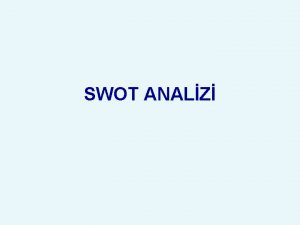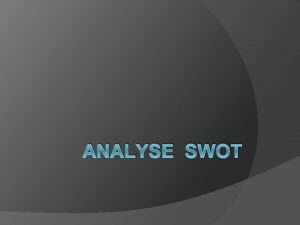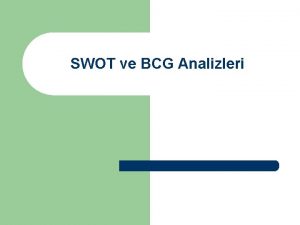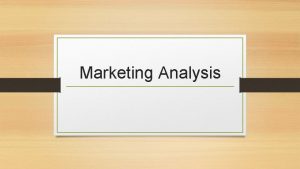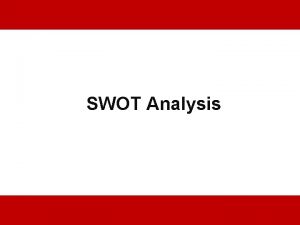SEM 2 4 05 PART II SWOT ANALYSIS













- Slides: 13

SEM 2 4. 05 PART II SWOT ANALYSIS

What is SWOT? � SWOT is an anagram that stands for Strengths, Weaknesses, Opportunities, and Threats.

Strengths, Weaknesses, Opportunities, and Threats � Strength � Any resource or capability your business has that can help you gain a competitive advantage in your industry � Weakness � Any limitation or shortcoming your business has that can keep you from achieving your objectives � Opportunity � Any favorable situation in the environment surrounding your business � Threat � Any unfavorable situation in the environment surrounding your business


BENEFITS Benefits of conducting a SWOT analysis: � Becoming aware of issues that you hadn’t thought of before � Having a “filter” for a great deal of information � Gaining new insights about your business environment by applying SWOT to a competitor’s company

STRENGTHS �Strengths are internal - under your control. ○ What are our advantages? ○ What do well (what is our expertise)? ○ What are our assets? ○ What resources do we have access to? ○ Where are we making money?

STRENGTHS �Examples of strengths: ○ A product or service that you offer that no one else in your area does ○ A convenient location ○ Strong brand recognition ○ The skills and talents of your staff �Once a SWOT analysis identifies an internal strength, a business can use that strength to take advantage of a external opportunity

WEAKNESSES �Weaknesses are internal - under your control. ○ What can we improve? ○ What resources do we lack? ○ Where are we losing money? ○ What are our competitors doing better than we are? �Examples of Weaknesses: ○ Lack of expertise, experience, or management depth ○ Bad reputation among the public ○ Poor communication among staff members ○ Weak brand name

QUESTION �A SWOT analysis indicates that customers' buying preferences are changing, but the business has a very limited product line. This is an example of an external threat attacking an internal weakness

OPPORTUNITIES �Opportunities are external -out of your control. �Collect information about the environment surrounding your business. ○ What are the newest technological breakthroughs? ○ What new needs of customers can we meet? ○ What economic trends are beneficial to us? ○ What niches have our competitors missed?

OPPORTUNITIES �Examples of opportunities: ○ A new software development ○ An improved mechanical process ○ A corporate merger ○ Failure of another company

THREATS �Threats are external - of your control. ○ What obstacles do we face? ○ What is our competition doing? ○ What economic trends are harmful to us? ○ Where are we vulnerable? ○ Do we have money problems? �Examples of threats: ○ New competition moving into your area ○ A new tax that your business owes the government ○ A new law that your business must follow ○ Government regulation ○ A new trend sweeping the public

 Sem sem sem
Sem sem sem Intertextualidade implícita e explícita
Intertextualidade implícita e explícita O que motivou felipe a reduzir as suas mentiras
O que motivou felipe a reduzir as suas mentiras Addition symbol
Addition symbol Part to part ratio definition
Part to part ratio definition Brainpop ratios
Brainpop ratios Part by part technical description example
Part by part technical description example Components of a bar
Components of a bar The part of a shadow surrounding the darkest part
The part of a shadow surrounding the darkest part Two way anova minitab 17
Two way anova minitab 17 Zara swot analysis
Zara swot analysis Swot analysis for whole foods
Swot analysis for whole foods Lenovo vision statement
Lenovo vision statement Swot analysis for procurement department
Swot analysis for procurement department















